Back to Homepage / Blogs / Nov 2018
A Glimpse into the History of Andaman and Nicobar Islands
The Andaman and Nicobar Islands (ANI) refer to two island groups – the Andaman Islands and the Nicobar Islands – located east of the Indian mainland in the Bay of Bengal. Together, the two islands make up of over 500 islets, and are
separated by the Ten Degree Channel spanning 150 km. An Indian territory covering approximately 3,185 square miles, the islands have, in recent years, caught the attention of leisure tourists drawn to their stunning scenic beauty and
interesting history.
A brief history of the ANI
Archaeological evidence documenting around 2,200 years indicate that the indigenous Andamanese people may have been cut-off from other populations during the Middle
Paleolithic era, and diversified into different territorial groups. Meanwhile, people of various backgrounds occupied the Nicobar Islands, and over time, united into two groups speaking Shompen and Mon-Khmer languages.
There are
more theories than facts about the origin of ANI. Ancient Indian epic poem Ramayana contains references to Lord Rama seeking to bridge the sea to find his kidnapped wife Sita with the help of monkey-god Hanuman, and that it was achieved by
grouping islands who inhabitants were known as Handuman, from whom the name 'Andaman' was derived.
Another theory brings in a Malay association, claiming that ancient Malays owned slaves on the 'island of Handuman' and traveled
here by sea to capture aboriginals and sell them. Another reference is found in the work of Chinese Buddhist pilgrim I-tsing, who embarked on a voyage to India in 671 A.D. and called the islands 'the islands of cannibals' or 'Andaban', even
describing the place in detail, including the barter of coconut for iron.
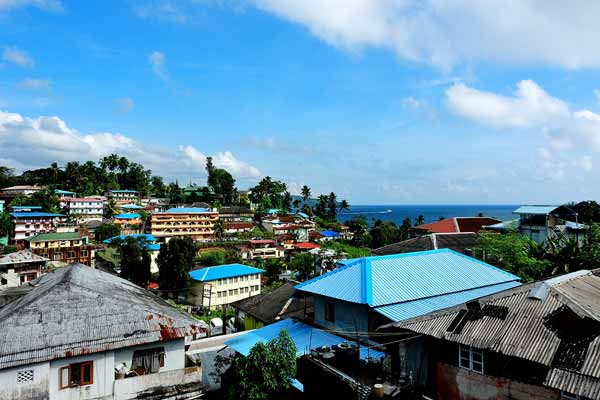
Port Blair
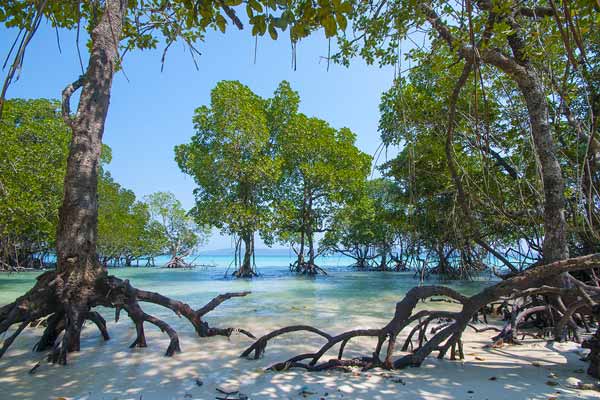
Radhanagar Beach on Havelock
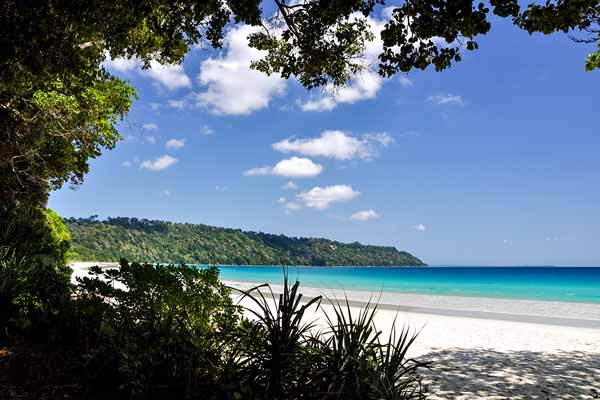
Havelock Island Beach
Marco Polo stopped at the Andamans en route his voyage to China in 1290 A.D. In his book Oriente Poliano or The Travels of Marco Polo, the legendary traveler speaks of the 'Angamanain' island whose people he describes as having 'heads,
teeth and eyes like dogs' and the propensity to eat everyone they can catch. He also mentions that the islanders don't have a king, and subsist on flesh, milk, rice and fruits that he has never seen before.
The Chola Empire, one of
the longest-ruling dynasties ever, whose antiquity is unknown, used the islands as a strategic naval base to combat the Sriwijaya Empire (modern day Indonesia). The Cholas called the islands Ma-Nakkavaram or 'naked land' as well as
Tinmaittivu or 'impure islands'. The islands also served as a maritime base for ships belonging to the Maratha Empire. Navy Admiral Kanhoji Angre bolstered naval supremacy by setting up base on the islands. Maratha rulers also attached the
islands to India, with the ANI today one of the seven union territories of the country.
In 1755, the Danish East India Company made the Nicobar Islands a Danish colony, changing their name to New Denmark and later Frederick's
Islands. Bouts of malarial outbreaks caused a change of heart and Danish colonizers eventually bid adieu to the islands in 1848.
The British East India Company found the islands ideal to hold mutineers of the Indian Rebellion, a
major but unsuccessful rebellion against the British rule. In 1858, Dr. James Walker landed in Port Blair on a frigate hauling hundreds of convicts. Taking advantage of the heavy rainfall and aware that the Andamans were connected to Burma
by land, the convicts make attempts to escape. The islanders killed many of the convicts, captured men were hanged, and some who had fled to the jungles surrendered. Among many more mutineers who were packed off to the islands, some died of
malaria and dysentery. Walker was admonished and instructed to make peace with the aborigines and allow well-behaved convicts to relocate their family from India to the islands.
The penal settlement gradually expanded. Forests were
cleared to plant rice, vegetables, coconut trees and bananas. In 1896, construction of the Cellular Jail began. It was initially envisioned to architecturally resemble a prison in Pennsylvania but later inspired by the HM Prison Pentonville,
the Category B men's prison operated by Her Majesty's Prison Service. Nearby, a church, mess, barracks and a residence for the Chief Commissioner were built, followed by tennis courts, a golf course and football grounds. A school for
convicts' children also became a part of the district. Cellular Jail had 698 cells designed to hold mutineers in solitary confinement, and housed such notable dissidents as Vinayak Damodar Savarkar, Yogendra Shukla and Batukeshwar Dutt.
In 1868, over 200 inmates tried to break out of jail but captured soon after. Walker ordered some to be hanged. In 1933, inmates began a hunger strike opposing the treatment of prisoners; three among then died from force-feeding. After
intervention from Mahatma Gandhi and Rabindranath Tagore, inmates were repatriated from the jail in 1938.
Cellular Jail is one of the island's key modern-day tourist attractions. It resembles a wheel with the central tower as the
main axle and seven wings as spokes. Its Panopticon design scheme allowed for all inmates to be observed by a single guard without prisoners able to decipher whether or not they are being watched.
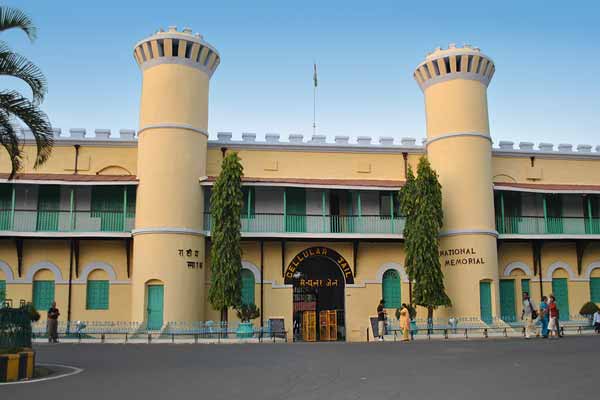
Cellular Jail
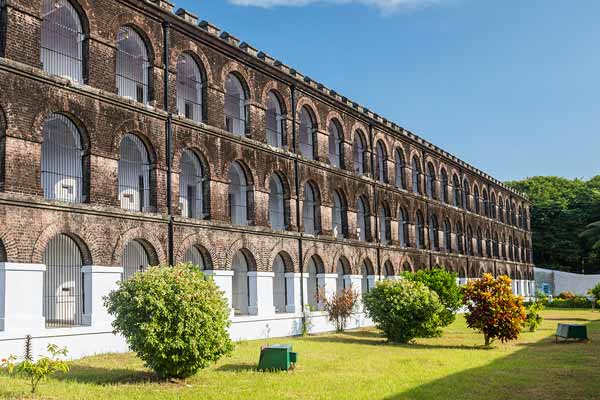
Cellular Jail
During the Second World War, the islands caught the attention of the Japanese because they could hold a large number of ships. By that time, only one British Infantry company was stationed at Ross. Between 1941 and 1942, the Imperial
Japanese Army Air Service began air raids on Rangoon. After the fall of Burma, the garrison convicts, settlers and officials were evacuated. Only a few British officers and those who had no home elsewhere chose to stay back. One of the
officers was executed by the Japanese. During this time, Netaji Subhash Chandra Bose, a freedom fighter who collaborated with Imperial Japan and Nazi Germany to drive the British out of India, visited the islands and offered the moniker
Swaraj-dweep' or self-rule island.
After India and Burma gained independence, the British moved to resettle Anglo-Indians and Anglo-Burmese on the islands. Their plan failed and in 1950, the Andaman and Nicobar Islands became a
part of India and a union territory in 1956.
Original inhabitants of the ANI
Four Negrito and two Mongoloid tribes are the indigenous inhabitants of the Andaman Islands, having lived here for 30,000-40,000 years.
Settlers to the islands arrived in the 1950s, after being persuaded by the Indian government to inhabit large swathes of unoccupied land, with 10 acres of free land as inducement.
Negritos comprise different ethnic groups
inhabiting, besides ANI, Peninsular Malaysia, Southern Thailand and Philippines. They are characterized by their small stature and dark skin. The Negritos of ANI are claimed to resemble African pygmies. The Negrito tribes of ANI are the
Great Andamanese, Jarawa, Onge and Sentinelese.
The Great Andamanese originally consisted of ten tribes, each with its own language and population of 200-700 people. The British invasion decimated large numbers of tribe members and
in the 1970s, the Indian government moved survivors to the Strait Island, providing them shelter, food and clothing. Less than 60 Great Andamanese people exist today.
The Onge population has also declined and the territories they
occupied on Little Andaman Island have also shrunk, now shared with settlers from Bangladesh, India and the Nicobar Islands. And although their settlements fell prey to the Tsunami's fury in 2004, no tribe member lost their life. After
feeling the tremors and watching water levels recede, the Onge quick made their way inland and escaped the waves.
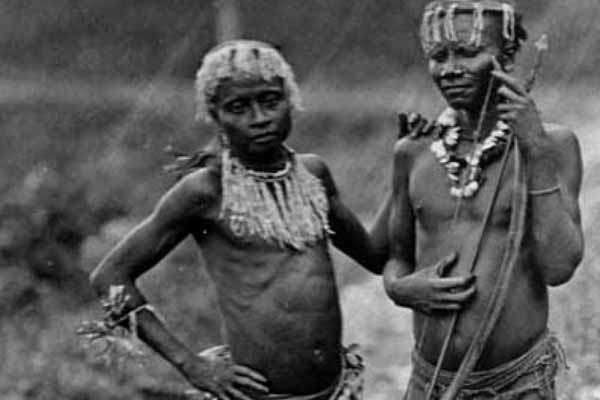
Tribes from the Andaman & Nicobar Islands
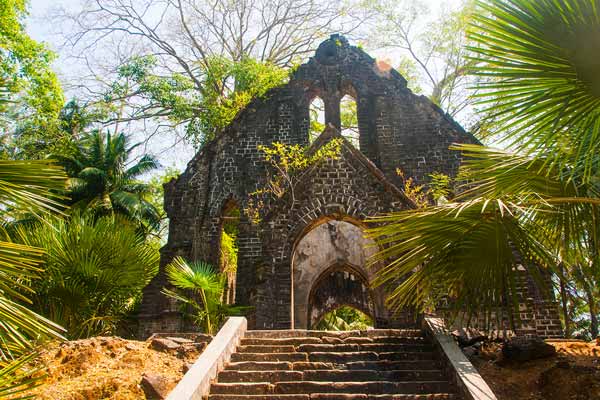
Abandoned church on Ross Island
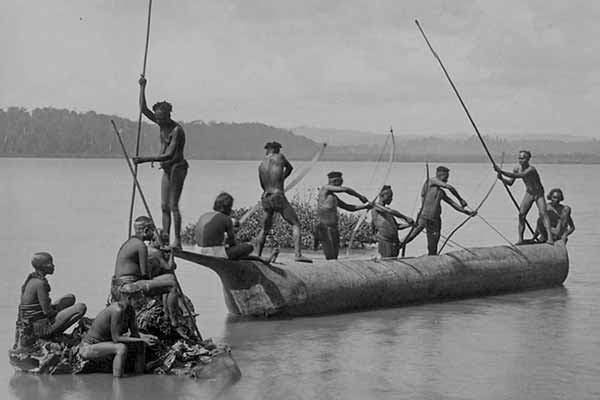
Tribes from the Andaman & Nicobar Islands
The Onge decorate their faces with white clay and chew bark to impart a reddish hue to their teeth. While they hunt for wild boar and collect honey, for the large part, the Onge rely on the Andaman authorities for food and
commodities.
The Sentinelese are one of the world's last uncontacted tribes, and live on the small North Sentinel island. They are highly resistant to human contact and have made their distaste for outsiders apparent in both
harmless and lethal ways. But the Sentinelese seem to be doing well – they enjoy good health and photographs have shown children and pregnant women. However, despite thriving in isolation and surviving the tsunami, they are at a risk of
falling prey to diseases to which they lack immunity, which also makes contact with them a dangerous proposition.
Like the Sentinelese, the Jarawa population is self-sufficient, although it does not live in extreme isolation. A few
tribe members first ventured out of the forest in the late nineties to explore nearby towns, and by the 2000s, authorities announced that the Jarawas would be free to decide their own future and won't be settled forcibly to bring them into
the mainstream.
Today, about 470 Jarawas co-exist with settlers. While most prefer to hunt and live amongst their own, a few can be seen walking along roads and interacting with tourists. Still, their survival is threatened by
illegal fishing and gathering by poachers. Concerns have also been expressed over the threat posed to the Jarawas by the encroaching Andaman Trunk Road.
The Nicobarese are one of the two Mongoloid tribes in the ANI. A designated
Scheduled Tribe, their population is estimated at 30,000. They depend on horticulture and receive free education from the government. The Shompen tribe, also a designated Scheduled Tribe, inhabits the interior of Great Nicobar Island, and
has a predominantly hunting-gathering culture, and some pig-rearing and horticultural activities. Relatively isolated, the tribe has a high male to female ratio, which has resulted in marriage by capturing women of different groups within
the tribe, and a large number of unmarried adult males.
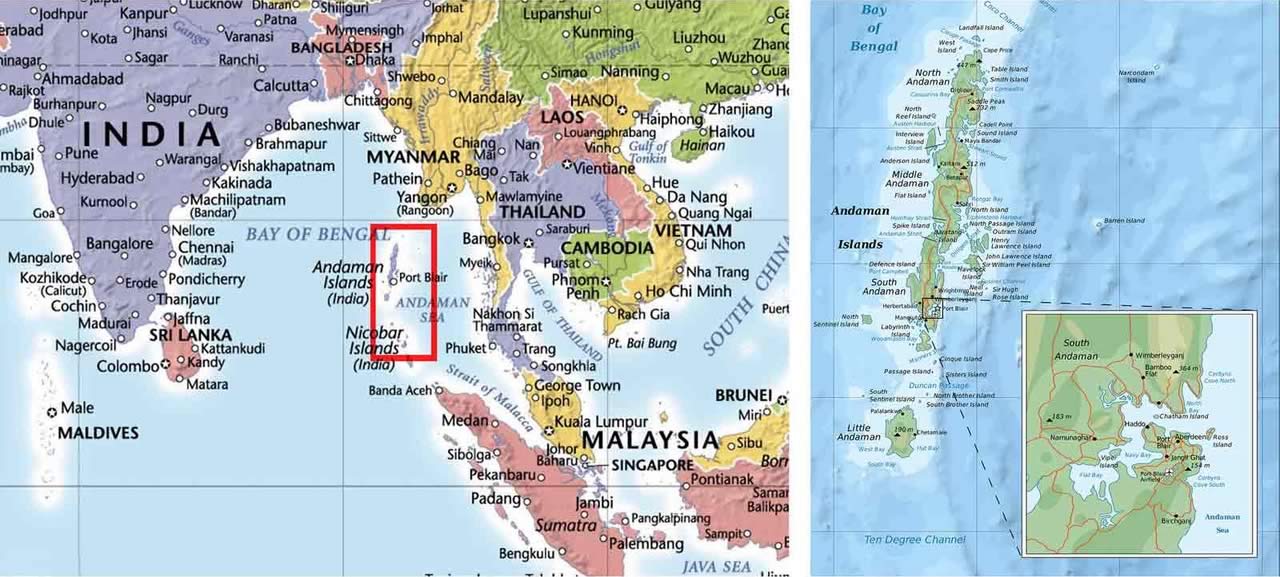
Map of the Andaman & Nicobar Islands
Flora and fauna
The islands are home to an impressively rich variety of flora and fauna. Their location in eastern Indian Ocean assures a warm tropical climate ranging from 22°C - 30°C, while annual rainfall ranges from 3,000
-3,800 millimeters. Close to 90% of the islands are forested, boasting more than 2000 plant species, many of which are endemic to the territory. Scattered with mangrove and coastal forests, the islands' trees can reach heights of 40-60
meters.
In the aftermath of the 2004 Indian Ocean Tsunami, Nicobar Islands lost more than 70% of their mangrove cover. However, researchers say that new habitats can potentially generate to regrow mangroves and new, unrecorded
mangrove species.
The islands' nine national parks and many wildlife and marine sanctuaries offer an opportunity to experience the diverse ecosystem. Whether you want to observe wildlife in their natural habitat or view innumerable
species of butterflies, ANI has you covered.
The islands are also a bird-watcher's paradise. Among the 200+ bird species found here are the Narcondam hornbill, Andaman wood pigeon, Andaman scop's owl, fulvous breasted woodpecker
and the blue-eared kingfish. Rain forests on the Andaman Islands are home to 45 reptile species, thirteen of which are endemic. The Malayan Box Turtle on the Nicobar Islands is the world's only non-marine turtle. Ten of the forty species of
snakes found here are venomous, including the Andaman Cobra, Andaman Krait, Pit Vipers, King Cobra and sea snakes.
Of the 62 mammal species on the island, 32 are endemic, including the Andaman Wild Pig, Crab Eating Macaque and
Andaman Masked Palm Civet.
The Indian government recently modified an earlier order that made it mandatory for foreign tourists to ANI to register with the Foreigners Registration Officer within 24 hours of their arrival. The white
sand beaches of Andaman have become a favorite tourist haunt in recent years; while some are buzzing with tourist activity, you will also find a few serene beaches that provide a private and tranquil experience.
Explore the
Andaman Islands on board the MY Andaman Explorer
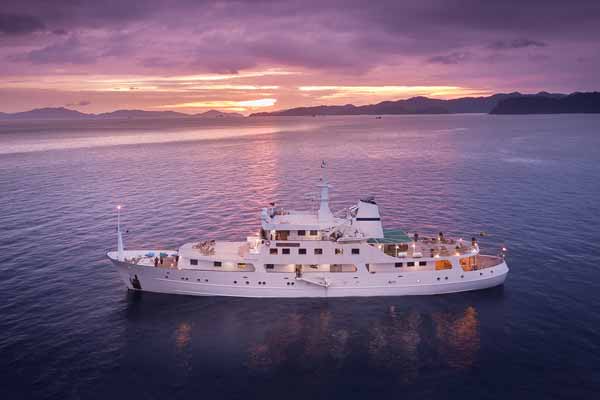
MY Andaman Explorer
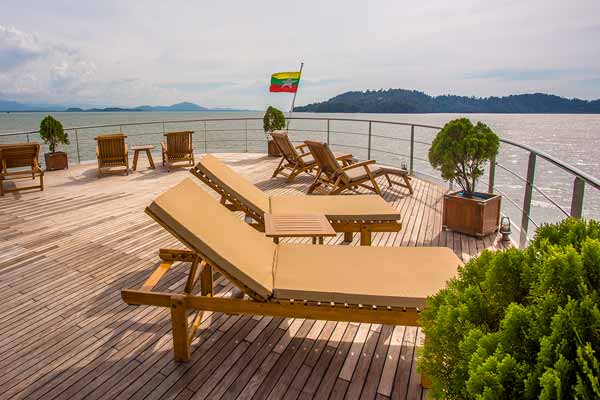
Deck on MY Andaman Explorer
Your expedition aboard the Andaman Explorer will take you through the South Andaman Island with its beautiful ferns and orchards, Havelock and Lawrence Islands that house some of ANI's best beaches for swimming and snorkeling, Northern
Andaman Island where you can interact with local communities and partake in folk dances and workshops, Mayabunder where you can gain insights into Karen cultural life, and Rangat Bay and Long Island whose virgin beaches promise an idyllic
experience.